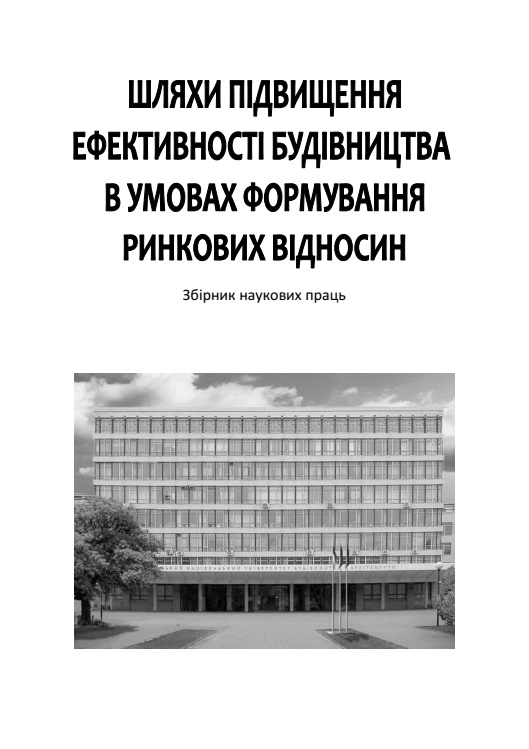Empirical assessment of the security of economic development of construction enterprises: the European aspect
DOI:
https://doi.org/10.32347/2707-501x.2019.40.3-18Keywords:
economic development balance, integral indicator of construction dynamics, dynamics of the number of people employed in construction, dynamics of construction of buildings, dynamics of the number of building permits issued, cluster analysis, threat of overheating in construction, “safe development”,Abstract
The article analyzes the dynamics of the development of the main indicators of the construction industry in the countries of the European Union. The main causes of the unbalanced growth of the construction business in Ukraine and European countries are established. The author suggests a methodical approach to assessing the threat of self-destruction of construction enterprises in the process of unbalanced development. The proposed approach is based on a comprehensive assessment of the proportionality of growth in construction indicators using an integral indicator and the main provisions of the theory of fuzzy sets. A fuzzy term “safe development” and its membership function are formulated. The configuration and parameters of the membership function are determined on the basis of the results of cluster analysis of the balance of economic development of the construction industry in the countries of the European Union. With the help of the developed methodological approach, the probability of the threat of unbalanced development for the domestic construction industry was assessed.
References
Andrusiv, S. V. (2017), “Stratehichni priorytety rozvytku budivel'noi haluzi derzhavy”, Naukovyj visnyk Uzhhorods'koho natsional'noho universytetu. Seriia : Mizhnarodni ekonomichni vidnosyny ta svitove hospodarstvo, vol.16(1). - pp. 10-13.
Bazilins'ka, O.Ya. (2009), Makroekonomika, 2nd ed, Tsentr uchbovoi literatury, Kyiv, Ukraine.
Brun'ko, P. V. (2015), “Osoblyvosti diial'nosti pidpryiemstv budivel'noi haluzi”, Formuvannia rynkovykh vidnosyn v Ukraini,vol.№ 7/8, pp. 151–156.
Hanzha, V. V. (2017), “Realizatsiia eksportnoho potentsialu budivel'noi haluzi Ukrainy”, Formuvannia rynkovykh vidnosyn v Ukraini, vol. 12, pp. 103-109.
Ekonomichna statystyka / Ekonomichna diial'nist' / Budivnytstvo, available at: http://www.ukrstat.gov.ua/
Zajtsev, O. V. (2016), “Monetarna infliatsiia ta ii zv'iazok z indeksom tsin u budivel'nij haluzi Ukraini”,Naukovyj visnyk Mizhnarodnoho humanitarnoho universytetu, vol. 22, pp. 123-128. available at : http://nbuv.gov.ua/UJRN/Nvmgu_eim_2016_22_29
Kosevtsov, V.O. and Biy'ko I.F. (1996),Natsional'na bezpeka Ukrainy: problemy ta shliakhy realizatsii priorytetnykh natsional'nykh interesiv, NISD, Kyiv, Ukraine.
Prunenko, D. O. and Lysenko, A. M. (2017), “Porivnial'nyj analiz funktsionuvannia budivel'noi haluzi: vitchyznianyj ta ievropejs'kyj aspekty”,Komunal'ne hospodarstvo mist. Seriia : Tekhnichni nauky ta arkhitektura,vol. 134, pp. 8-14. available at: http://nbuv.gov.ua/UJRN/kgm_tech_2017_134_4
Salamats'ka, O. Yu. (2012), “Vplyv makromarketynhovoho seredovyscha na budivel'nu haluz' Ukrainy”,Biuleten' Mizhnarodnoho Nobelivs'koho ekonomichnoho forumu, vol. 1(2), pp. 330–337. - available at: http://nbuv.gov.ua/UJRN/bmef_2012_1%282%29__49
Franchuk, V. I. and Volianiuk, V. V. (2014), “Ctan budivel'noi haluzi ta ii vplyv na ekonomichnu bezpeku budivel'no-hospodars'kykh hipermarketiv”, Naukovyj visnyk L'vivs'koho derzhavnoho universytetu vnutrishnikh sprav. seriia ekonomichna, vol. 2, pp. 235-243. - available at: http://nbuv.gov.ua/UJRN/Nvldu_e_2014_2_27
Shevchenko, V. S. (2013), “Diahnostuvannia peredumov ta faktoriv rozvytku budivel'noi haluzi Ukrainy”, Investytsii: praktyka ta dosvid, vol.2, pp. 59-64. - available at: http://nbuv.gov.ua/UJRN/ipd_2013_2_17
Production in construction - quarterly data/ Yevrostat, available at: http://appsso.eurostat.ec.europa.eu/nui/show.do?dataset=sts_copr_q&lang=en
Downloads
Published
How to Cite
Issue
Section
License

This work is licensed under a Creative Commons Attribution 4.0 International License.
Authors who publish with this journal agree to the following terms:
- Authors retain copyright and grant the journal right of first publication with the work simultaneously licensed under a Creative Commons Attribution License that allows others to share the work with an acknowledgement of the work's authorship and initial publication in this journal.
- Authors are able to enter into separate, additional contractual arrangements for the non-exclusive distribution of the journal's published version of the work (e.g., post it to an institutional repository or publish it in a book), with an acknowledgement of its initial publication in this journal.
- Authors are permitted and encouraged to post their work online (e.g., in institutional repositories or on their website) prior to and during the submission process, as it can lead to productive exchanges, as well as earlier and greater citation of published work (See The Effect of Open Access).

